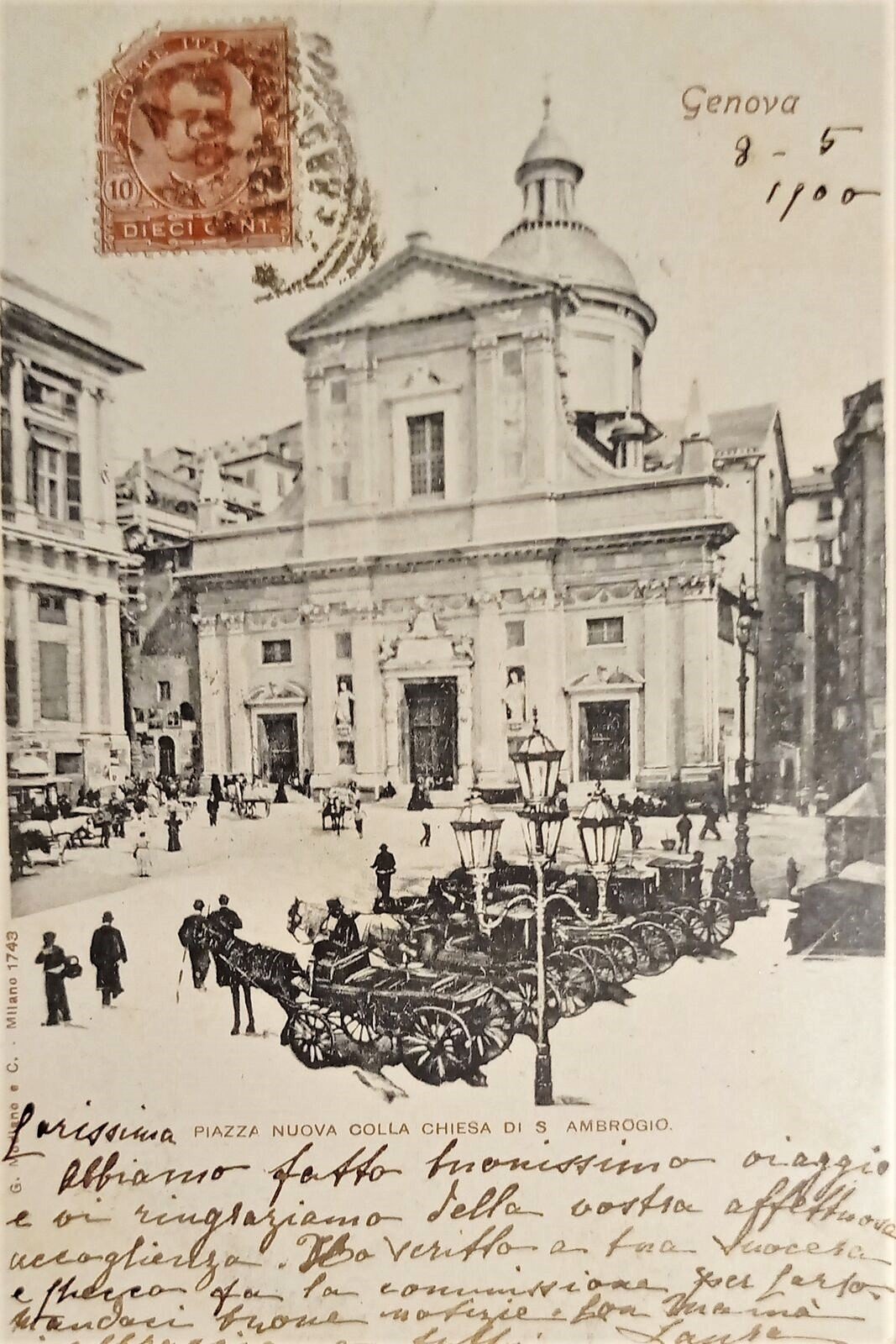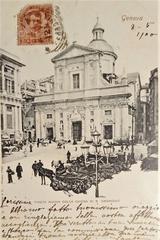
Chiesa del Gesù e dei Santi Ambrogio e Andrea, Genoa: Visitor Guide, History, and Practical Information
Date: 14/06/2025
Introduction
Located in the vibrant heart of Genoa, the Chiesa del Gesù e dei Santi Ambrogio e Andrea is a magnificent testament to the city’s religious, artistic, and architectural heritage. This Baroque masterpiece, rooted in centuries of ecclesiastical history, stands as a symbol of Genoa’s spiritual and civic evolution. From its early medieval origins to its transformation under the Jesuits and its continued role as a living monument, the church invites visitors to explore a rich tapestry of history, art, and culture.
This comprehensive guide provides detailed information on the church’s history, architecture, artistic treasures, visiting hours, accessibility, guided tours, and nearby attractions. Whether you are an art lover, history enthusiast, or a curious traveler, the Chiesa del Gesù e dei Santi Ambrogio e Andrea offers an immersive journey into Genoa’s glorious past and vibrant present.
For further details and up-to-date visitor information, consult the official Genoa tourism website and Nomads Travel Guide.
Table of Contents
- Origins and Historical Background
- Jesuit Transformation and Baroque Splendor
- Architectural Evolution and Facade
- Artistic Masterpieces and Interior Highlights
- Practical Visitor Information
- Guided Tours and Visitor Services
- Nearby Attractions and Suggested Itineraries
- Frequently Asked Questions (FAQ)
- Summary and Recommendations
- References
Origins and Historical Background
The origins of the Chiesa del Gesù e dei Santi Ambrogio e Andrea date back to the 6th and 7th centuries, when Genoa became a sanctuary for clergy and citizens fleeing Lombard invasions. Originally known as the “church of the Milanesi,” it was dedicated to Saint Ambrose, the patron saint of Milan, reflecting the strong Milanese influence on Genoa during this era. This connection persisted until the mid-7th century, after which the church remained a significant religious site for both locals and Milanese expatriates (visitgenoa.it; nomads-travel-guide.com).
Jesuit Transformation and Baroque Splendor
A transformative chapter began in 1522 when the Society of Jesus (Jesuits) assumed responsibility for the church. Embodying the Counter-Reformation’s ideals, the Jesuits sought to create a space that would inspire awe and devotion through grand art and architecture. In 1589, architect Giuseppe Valeriano led a comprehensive Baroque reconstruction, introducing a Latin cross plan, a prominent dome, and a richly decorated interior designed to engage the senses and uplift the spirit (nomads-travel-guide.com).
Architectural Evolution and Facade
The church’s architectural development reflects Genoa’s dynamic cultural shifts. The 16th-century Baroque makeover established the church’s monumental layout. In 1894, the facade was reimagined in Finale stone and marble, with statues of Saints Ambrose and Andrew by Michele Ramognino. The addition of the neobaroque bell tower in the early 20th century further enhanced its urban presence (visitgenoa.it; nomads-travel-guide.com).
Artistic Masterpieces and Interior Highlights
The interior of Chiesa del Gesù e dei Santi Ambrogio e Andrea is a showcase of Genoese Baroque art, generously supported by the city’s noble families. Highlights include:
- Peter Paul Rubens: “The Circumcision” (main altar), celebrated for its dramatic composition and vibrant palette, and “Saint Ignatius Healing an Obsessive Woman” (left aisle), affirming Jesuit themes (visitgenoa.it; nomads-travel-guide.com; Musei di Genova).
- Guido Reni: “The Assumption of the Virgin” (right aisle), known for its ethereal beauty and serene composition.
- Carlone Brothers: Giovanni Carlone and Giovanni Battista Carlone painted the vaults and dome with vibrant frescoes depicting biblical scenes, exemplifying Baroque dynamism (visitgenoa.it).
- Additional Works: Paintings by Simon Vouet, Domenico Piola, Giovanni Battista Merano, and sculptures by Giuseppe Carlone and Giovanni Domenico Casella adorn various chapels.
Polychrome marble, gilded stuccoes, and geometric marble floors contribute to the immersive Baroque aesthetic. The church’s “total work of art” approach merges painting, sculpture, and architecture seamlessly.
Practical Visitor Information
Visiting Hours and Tickets
- Opening Hours: Typically Tuesday–Sunday, 10:00 AM–6:00 PM. Some sources report 9:00 AM–12:00 PM and 3:00 PM–6:00 PM (Triphobo). Hours may vary during religious services and holidays; always check the official tourism website for updates.
- Admission: Entry is free. Donations are welcome to support ongoing preservation (visitgenoa.it).
Accessibility
- Wheelchair Access: The church is equipped with ramps at the main entrance and accessible restrooms. Assistance is available on request.
- Visitor Facilities: Restrooms and a small gift shop are available. Some areas may have steps or uneven floors; contact the church in advance for specific needs.
Dress Code and Etiquette
- Modest dress is required—cover shoulders and knees.
- Quiet and respectful behavior is expected, especially during services.
- Photography without flash is allowed, but always check posted policies to protect artworks.
Guided Tours and Visitor Services
- Guided Tours: Available on weekends and by advance booking. Tours provide deeper insight into the church’s art and history and can be reserved via local agencies or the Audiala app.
- Self-Guided Visits: Information panels and occasional audio guides support independent exploration.
Nearby Attractions and Suggested Itineraries
The church’s central location near Piazza Matteotti, Palazzo Ducale, and Piazza De Ferrari makes it an ideal starting point for exploring Genoa’s historic center. Combine your visit with Genoa Cathedral, the Old Port, or a stroll along Via Garibaldi—home to UNESCO-listed palaces. Local cafés and eateries offer opportunities to sample Ligurian specialties.
Frequently Asked Questions (FAQ)
Q: What are the visiting hours?
A: Typically Tuesday–Sunday, 10:00 AM–6:00 PM; hours may vary during services or holidays (visitgenoa.it).
Q: Is there an entrance fee?
A: No, entry is free. Donations are appreciated.
Q: Is the church wheelchair accessible?
A: Yes, with ramps and accessible restrooms.
Q: Are guided tours available?
A: Yes, on weekends and by booking through local agencies or the Audiala app.
Q: Can I take photographs?
A: Non-flash photography is permitted; check current policies on arrival.
Q: How do I reach the church?
A: Located near Piazza Matteotti; accessible by bus lines and a short walk from Genova Piazza Principe station.
Summary and Recommendations
Chiesa del Gesù e dei Santi Ambrogio e Andrea is an essential stop for anyone interested in Genoa’s religious, cultural, and artistic heritage. Its remarkable Baroque architecture, world-class artworks, and welcoming visitor provisions make it a highlight of the city. To fully appreciate the church, arrive early, dress respectfully, and consider taking a guided tour for deeper insight. Leverage tools like the Audiala app for audio guides and stay updated on special events.
For more information and the latest updates, consult the official Genoa tourism website and Nomads Travel Guide.
References
- Visiting the Chiesa del Gesù e dei Santi Ambrogio e Andrea in Genoa: History, Art, and Visitor Information, 2025, VisitGenoa (visitgenoa.it)
- Jesuit Church of Santi Ambrogio e Andrea, 2025, Nomads Travel Guide (nomads-travel-guide.com)
- Chiesa Del Gesù Genoa: Visiting Hours, Tickets & Artistic Masterpieces, 2025, Genoa Tourism (visitgenoa.it)
- Visiting Chiesa del Gesù e dei Santi Ambrogio e Andrea: Hours, Tickets, and Genoa Historical Sites Guide, 2025, Triphobo (Triphobo)




































































































